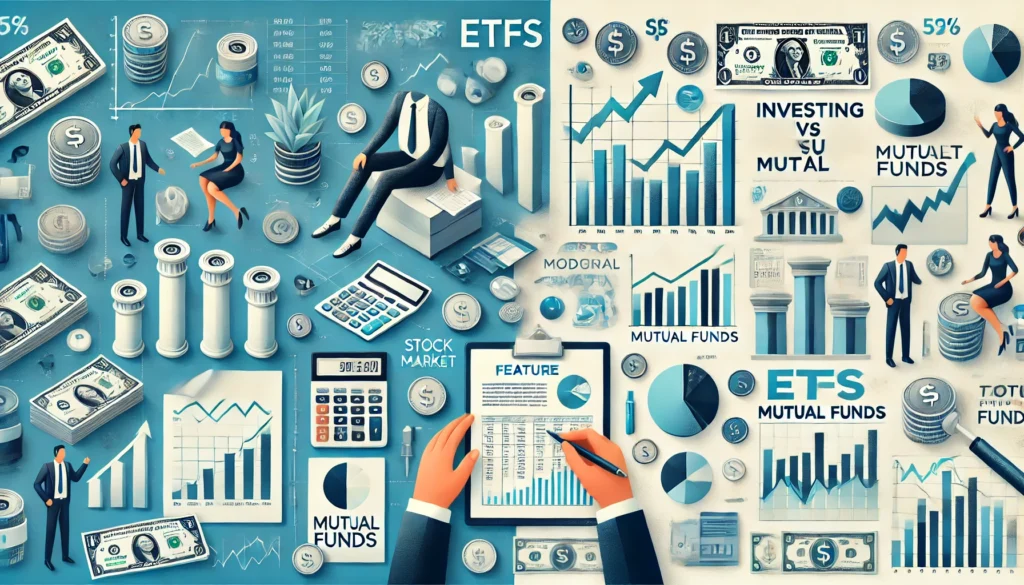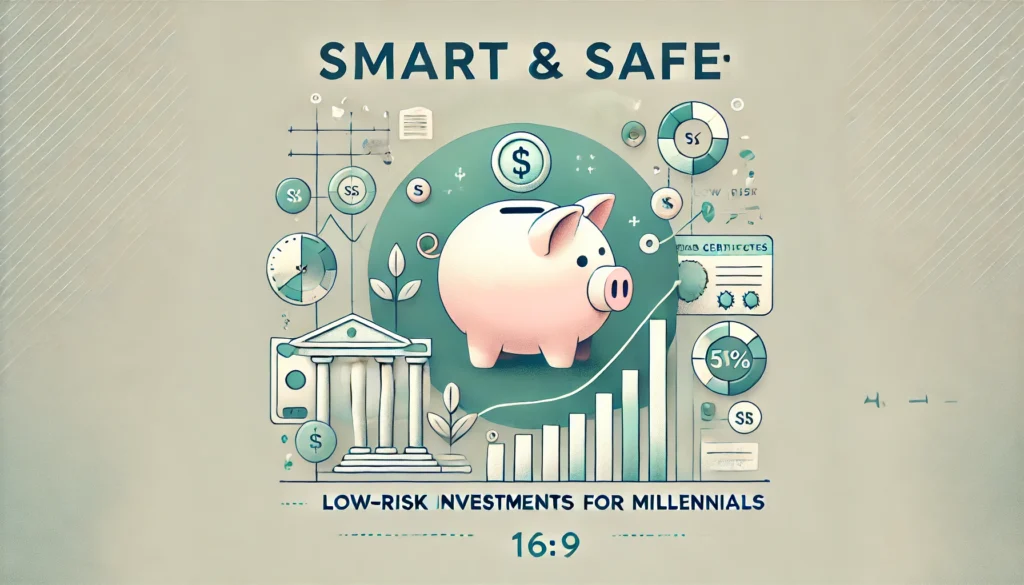When you’re looking to invest, it’s easy to feel overwhelmed by the sheer number of options out there. Yet, two of the most popular and accessible choices are Exchange-Traded Funds (ETFs) and Mutual Funds. Both can play a vital role in your path toward financial independence, enabling you to save money, invest wisely, and ultimately grow your net worth. But how do you decide which one is right for your goals, lifestyle, and risk tolerance?
In this comprehensive guide, we’ll break down the key differences between ETFs and mutual funds, uncover the benefits and drawbacks of each, and help you figure out which investment aligns best with your personal finance strategy. We’ll also include examples, practical tips, and additional reading suggestions to help you manage your investments in a savvy way.
1. Introduction: Why ETFs and Mutual Funds Matter
In a world where budgeting and frugal living are crucial for long-term financial success, the importance of investing cannot be overstated. Simply putting your money in a savings account might not be enough to combat inflation or reach your financial goals. To put your hard-earned savings to work, consider stepping into the realm of ETFs and mutual funds—two investment vehicles celebrated for their simplicity, accessibility, and potential for steady growth.
Both options provide a convenient way to diversify your portfolio—which means spreading out your risk across different asset classes like stocks, bonds, and sometimes even real estate. Diversification is a cornerstone of healthy personal finance because it helps cushion your portfolio against market volatility.
However, while ETFs and mutual funds might seem similar at first glance, there are some critical distinctions you need to understand before choosing one or the other—or both! By the end of this article, you’ll have the insights to confidently decide how to allocate your funds for maximum returns and minimal stress.
2. What Are ETFs?
An Exchange-Traded Fund (ETF) is essentially a collection of securities—like stocks or bonds—that you can buy or sell on a stock exchange, much like an individual stock. ETFs often track a particular index (such as the S&P 500) or focus on a specific sector (like technology or healthcare). For investors looking for a straightforward and transparent way to invest, ETFs can be a great fit.
2.1 How ETFs Work
- Structure: ETFs are typically designed to mirror the performance of a given index or strategy. For instance, an S&P 500 ETF holds shares of all (or most) of the companies in the S&P 500 in proportions that match the index.
- Trading: You can buy and sell ETF shares throughout the trading day. This means prices fluctuate in real-time, just like individual stocks.
- Expense Ratios: ETFs often boast lower expense ratios compared to many actively managed mutual funds. This is because most ETFs are passively managed, tracking an index rather than attempting to outperform it.
2.2 Common Types of ETFs
- Index ETFs: Track a stock market index like the S&P 500 or NASDAQ.
- Bond ETFs: Focus on government, corporate, or municipal bonds, offering a stable income stream.
- Sector ETFs: Invest in specific market sectors, such as technology, healthcare, or energy.
- Commodity ETFs: Track the price of commodities like gold, silver, or oil.
- International ETFs: Provide exposure to foreign markets, helping you diversify internationally.
2.3 Advantages of Investing in ETFs
- Cost-Effectiveness: ETFs generally have lower expense ratios compared to actively managed mutual funds, making them attractive to frugal investors.
- Tax Efficiency: Due to their unique creation/redemption mechanism, ETFs often generate fewer capital gains distributions, resulting in lower tax bills for holders (although this depends on your country’s tax regulations).
- Intraday Trading: Since ETFs trade like stocks, you can buy and sell any time during market hours, giving you more flexibility.
- Transparency: Most ETFs disclose their holdings daily, which can give you a better understanding of where your money goes.
2.4 Potential Drawbacks of ETFs
- Trading Costs: Frequent trading of ETFs can rack up brokerage fees, undermining cost advantages if you’re not careful. However, many platforms now offer commission-free ETF trades.
- Bid-Ask Spreads: The difference between the buying price and selling price (the bid-ask spread) can be larger for less liquid ETFs, potentially affecting the price you pay.
- Over-Trading Temptation: The ability to trade intraday can lure some investors into day-trading or trying to time the market, which can be risky and unproductive for long-term goals.
3. What Are Mutual Funds?
A Mutual Fund is a pooled investment vehicle managed by professional fund managers. The fund collects money from many investors and invests in a diversified basket of assets, such as stocks, bonds, or both. Mutual funds have been around for decades and remain a popular choice for investors who prefer a more hands-off, guided approach.
3.1 How Mutual Funds Work
- Structure: A mutual fund issues shares based on the fund’s net asset value (NAV). The NAV is calculated once per day, after the market closes.
- Management: Many mutual funds are actively managed, meaning a professional manager makes decisions to buy or sell assets to beat a market index. Some mutual funds are passively managed, mirroring an index in a way similar to ETFs.
- Fees: Mutual funds often come with expense ratios that include the fund manager’s fees, distribution costs, and other operational expenses.
3.2 Common Types of Mutual Funds
- Equity Funds: Invest primarily in stocks. Can be further classified by style (growth, value) or market cap (small-cap, mid-cap, large-cap).
- Bond Funds: Invest primarily in bonds, aiming for steady income and lower risk compared to equity funds.
- Balanced Funds: A mix of stocks and bonds, designed to balance growth and income.
- Index Funds: Track a market index, usually with lower expense ratios than actively managed funds.
- Target-Date Funds: Adjust the asset allocation over time, becoming more conservative as the target retirement date nears.
3.3 Advantages of Investing in Mutual Funds
- Professional Management: Active mutual funds can offer the expertise of seasoned managers who aim to outperform the market.
- Convenience: Mutual funds simplify investing by allowing you to own a diversified collection of assets in a single purchase.
- Reinvestment of Dividends: Most mutual funds offer automatic dividend reinvestment, helping you compound your returns over time.
- Predictability: Since the NAV is priced once a day, you won’t have to track intraday fluctuations if that stresses you out.
3.4 Potential Drawbacks of Mutual Funds
- Higher Fees: Actively managed mutual funds can charge higher expense ratios than ETFs or index mutual funds, which can eat into your returns over the long haul.
- Lack of Intraday Trading: You can only buy or sell a mutual fund at the closing NAV for that day, which might limit flexibility.
- Tax Inefficiencies: Mutual fund shareholders can be hit with capital gains distributions even if they didn’t sell shares personally, especially if the fund manager frequently trades holdings.
4. Key Differences Between ETFs and Mutual Funds
Even though ETFs and mutual funds offer diversification and share some common ground, there are notable differences that can influence your decision.
4.1 Cost Structure
- ETFs: Often have lower expense ratios and no front-end or back-end sales charges. However, watch for brokerage commissions if your platform charges them.
- Mutual Funds: Expense ratios can vary significantly, especially for actively managed funds. Some also charge sales loads (fees for buying or selling).
4.2 Trade Flexibility and Liquidity
- ETFs: Trade in real time on the stock market, allowing you to set limit orders and quickly react to market swings.
- Mutual Funds: Priced once per day at the fund’s NAV. Purchases or redemptions are executed after market close.
4.3 Minimum Investment Requirements
- ETFs: You can buy as few as one share (depending on your broker’s policies), making it easy to start with a small investment. Fractional share investing also exists on some platforms.
- Mutual Funds: Some funds require a minimum initial investment, often ranging from $1,000 to $3,000 or more.
4.4 Tax Implications
- ETFs: Their creation/redemption mechanism often makes them more tax-efficient. However, you may still owe capital gains taxes when you sell at a profit.
- Mutual Funds: Actively managed funds can distribute capital gains to shareholders, triggering tax events even if you haven’t sold your own shares.
4.5 Management Style
- ETFs: Most are passively managed index funds, though actively managed ETFs do exist.
- Mutual Funds: Many are actively managed, which can lead to higher fees. Index mutual funds, however, are also available for a lower-cost, passive approach.
5. Which Investment Is Right for You?
Choosing between ETFs and mutual funds isn’t a one-size-fits-all decision. Your unique investment strategy, goals, and personal preferences will shape what works best for you.
5.1 Your Investment Goals
- Long-Term Growth: If you’re aiming for long-term growth and want to keep costs low, both index ETFs and index mutual funds can be great choices.
- Income Generation: If you’re seeking regular income—say, if you’re nearing retirement or wanting consistent dividend payouts—bond ETFs or bond mutual funds could fit the bill.
- Broad Diversification: Both ETFs and mutual funds can give you a well-rounded portfolio. For example, you could invest in a broad market ETF or a balanced mutual fund to cover multiple asset classes.
5.2 Your Investing Style
- Hands-On: If you like intraday trading or adjusting your portfolio in real time, you might lean toward ETFs.
- Hands-Off: If you prefer to invest gradually, monitor less frequently, and let a fund manager handle adjustments, a mutual fund (especially a balanced or target-date fund) may be preferable.
5.3 Your Budget and Risk Tolerance
- Budget: If you’re starting with a smaller budget, ETFs might be more accessible due to lower initial investment requirements. Plus, if your broker offers commission-free ETFs, that’s an added benefit.
- Risk Tolerance: Both ETFs and mutual funds come in varying levels of risk. More aggressive stock-focused options carry higher volatility, whereas bond or balanced funds offer stability. Choose based on your comfort with market ups and downs.
5.4 Your Time Horizon
- Short-Term: Neither ETFs nor mutual funds are inherently “get rich quick” vehicles. However, ETFs do allow intraday trading, which can be helpful if you need to sell quickly—though frequent trading can be risky.
- Long-Term: For a 5- to 30-year time horizon, the differences in daily pricing between ETFs and mutual funds may not significantly impact your ultimate returns if you choose low-cost, well-managed funds.
6. Building a Diversified Portfolio
Regardless of whether you choose ETFs, mutual funds, or a combination of both, diversification is a key principle in smart money management. Here are some ways to diversify:
- Mix of Asset Classes: Combine stocks, bonds, and other assets such as real estate or commodities to spread your risk.
- Global Exposure: Incorporate international funds or ETFs so that your performance isn’t solely tied to your home market.
- Variety of Strategies: Consider a blend of index-tracking and actively managed options if you believe in a particular manager’s skill.
Pro Tip: Many investors have found success by blending a core of low-cost index ETFs or mutual funds (to cover broad equity and bond markets) with smaller allocations to specialty funds or sectors they find promising.
7. Actionable Tips for Smart ETF and Mutual Fund Investing
- Compare Expense Ratios: This might sound repetitive, but fees matter—a lot. Over time, even a 0.5% difference in fees can substantially affect your returns.
- Avoid Emotional Trading: Whether you use ETFs or mutual funds, don’t let short-term market swings dictate your decisions. Focus on your long-term goals and re-evaluate your portfolio periodically, not daily.
- Automate Your Contributions: Consider setting up automatic transfers from your checking account into your investment account, so you consistently buy shares. This approach, known as dollar-cost averaging, helps reduce the impact of market volatility on your investments.
- Read the Prospectus: Before investing, check the fund’s prospectus to understand its objective, historical performance, and fees.
- Keep Track of Taxes: Note that different funds can have different tax implications. If you’re investing through a tax-advantaged account (e.g., IRA, 401(k), or equivalent in your country), capital gains distributions might be less of a worry.
- Rebalance Periodically: Over time, certain holdings might grow faster than others, causing your portfolio to become unbalanced. Rebalancing ensures you maintain the right asset allocation for your goals.
- Stay Educated: Markets evolve. Keep learning about new ETF or mutual fund options, changes in the industry, and overall economic conditions. This will help you refine your strategy over time.
8. Conclusion and Motivational Takeaways
Choosing between ETFs vs mutual funds boils down to understanding your own investing style, budget, and long-term objectives. Both investment vehicles can help you achieve financial independence if you practice disciplined, consistent investing. Here are a few motivational takeaways to keep you inspired:
- Action Over Perfection: Starting to invest—even if with a small amount—is often more important than waiting for the “perfect” time.
- Embrace Consistency: Automating your contributions and focusing on low-cost, diverse funds can set you on a stable path to wealth building.
- Stay Curious: The investment world doesn’t stand still. Keep learning, adapting, and refining your approach. Over time, your knowledge will pay off in the form of higher confidence and better decision-making.
- Reward Yourself: Investing is not just about hoarding money for the future; it’s about eventually enjoying the life you envision. Celebrate small wins and stay motivated to continue good financial habits.
Remember: You don’t have to choose exclusively between ETFs and mutual funds. Many successful investors hold both in their portfolios to benefit from the strengths of each. By doing your research and employing solid personal finance principles, you can systematically move toward your financial goals.
By comparing the strengths and weaknesses of ETFs vs mutual funds, you’ll be better equipped to make informed decisions that align with your personal goals. Whether you’re focused on frugal living, saving money, or planning for an early retirement, these two investment vehicles can serve as powerful building blocks for your long-term wealth strategy. Take the information from this guide, consider your own aspirations, and start putting your money to work in a way that fits your lifestyle. Happy investing!



